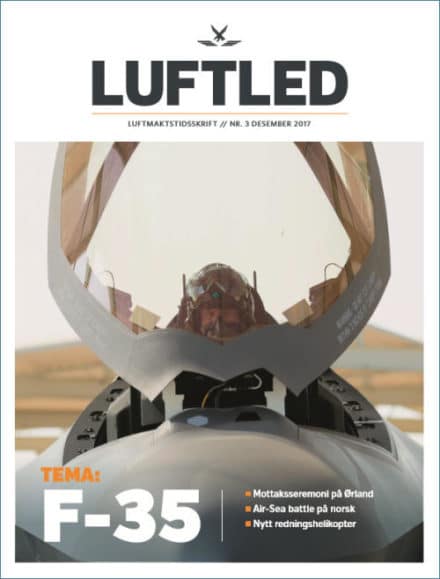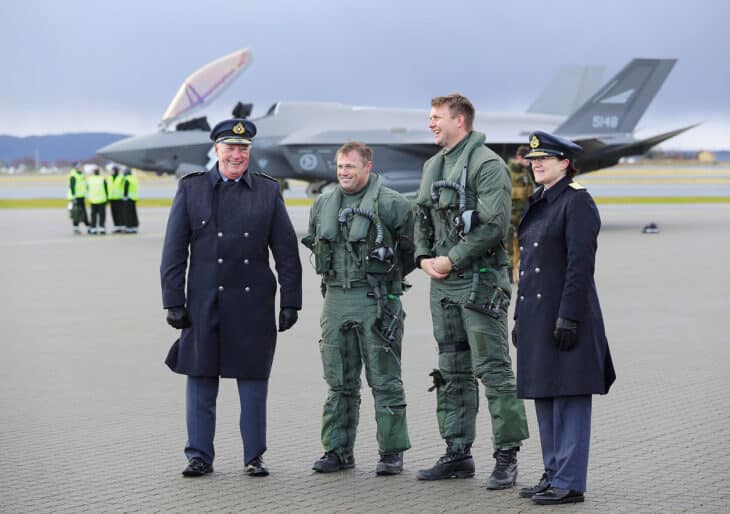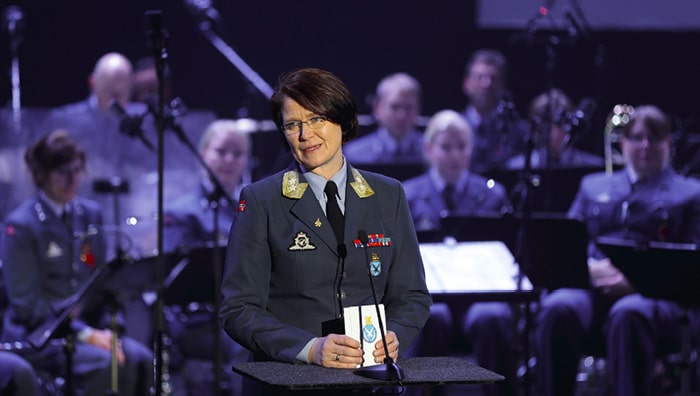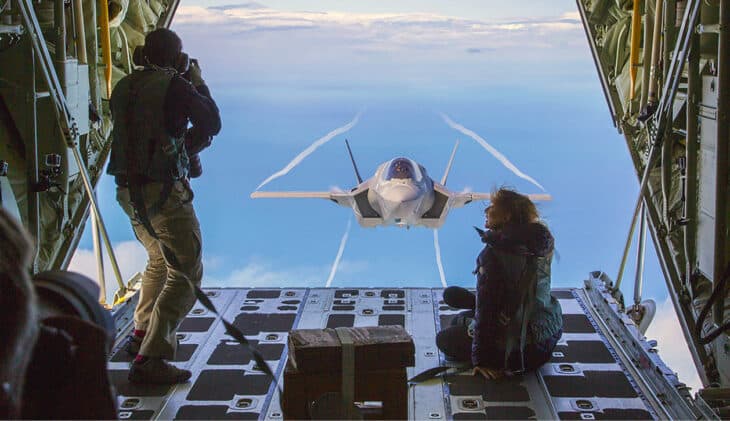F-35s Over the North Sea; Future RAF-RNoAF Cooperation
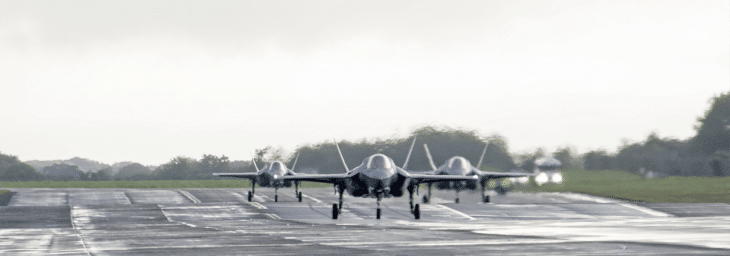
The RNoAF is preparing for the arrival of its first F-35A at Ørland Air Station in November 2018 and expects to eventually operate a fleet of 52 F-35As which will enable it to phase out its ageing F-16A/B fleet which has served Norway well but is amongst the most heavily used F-16 fleets still in frontline service globally. Meanwhile, the RAF and Royal Navy will take delivery of 48 F-35B Short Take-Off and Vertical Landing (STOVL) aircraft by the mid-2020s, with an eventual nominal order of 138. However, it is not clear that Britain will ever purchase the entire 138 and there is also a question mark over whether the remainder of the purchase after the initial 48 will be of the F-35B or F-35A variants, with the latter offering greater range, payload and lower costs but unable to operate from the Royal Navy’s new Queen Elizabeth class aircraft carriers. What is certain is that for the first decade of F-35 frontline service in Europe, Norway and the UK will operate predominantly different variants of the aircraft.
Same software
The F-35 has many features which lend themselves to improving cooperation and integration between partner air forces compared to legacy platforms such as Tornado, F-16 and Eurofighter Typhoon. The most obvious of these is airframe and software commonality. Software in particular has often in the past been a sticking point for interoperability, let alone deeper forms of integration, with even air forces operating the same basic aircraft type fielding different software iterations, blocks and upgrade pathways.
The F-35 is at heart a software driven and software dependent set of capabilities combined in a low-observable airframe, and as such the major interoperability and multinational integration challenges and opportunities are software rather than hardware dependent. This is important given that the F-35 versions which the RAF and RNoAF will initially operate have significant airframe and internal hardware differences. By contrast, the software that drives both versions’ combat and network capabilities is the same and will follow almost exactly the same upgrade path driven centrally by the Pentagon and Lockheed Martin. The well-publicised difficulties inherent in bringing even the baseline Block 3i software to combat-ready maturity levels, let alone sorting out Block 4 towards the early 2020s points to a level of complexity which is very likely to mitigate strongly against individual partner nations like Norway and the UK deviating significantly away from the US-led software standards for the foreseeable future; arguably future-proofing interoperability at the cost of practical sovereign capability to adapt the jet to specific national priorities.
This common software means that both nations’ aircraft will not only be equipped with the same datalink and communications suite, but more crucially the way in which their internal data management systems and sensor fusion functions process and display incoming information will also be the same. The upshot of this is that any datalink or other communications incompatibility between Norwegian and British F-35s is likely to be very much the exception rather than the rule. Whilst there may well be political reasons for limiting the degree to which certain aspects of mission data are shared between the two nations’ aircraft, the common software and communications suite should enable operational integration in training and live scenarios to be as close as politically desirable at any given stage in the aircraft’s service life, rather than being bounded by technical limitations.
Software in particular, has often in the past been a sticking point for interoperability, let alone deeper forms of integration, with even air forces operating the same basic aircraft type fielding different software iterations, blocks and upgrade pathways
Built in sensors
An often overlooked advantage which the F-35 offers over previous generations of fighters is that all the targeting and surveillance capabilities and electronic warfare equipment is built into the airframe rather than being added later as external pods or national upgrades. The current situation for most global fast jet fleets is that a shortage of the latest (expensive) targeting, jamming and ELINT gathering pods mean that those which are available are almost exclusively allocated to the highest readiness and forward deployed elements of the overall frontline fleet. By contrast, with the F-35 air forces will be able to genuinely train as they intend to fight since the airframes in use in the OCUs and across the whole frontline squadron establishment will all have such capabilities ‘built in’. For the UK and Norway, this will allow significantly more flexibility to develop tactics and experiment with frontline-standard kit during routine training and operations around the North Sea area.
However, the usefulness of the North Sea ranges for high-end warfighting training will be challenged by the F-35. Many of the F-35’s capabilities are designed to maintain awareness of and control over such large volumes of airspace that the current North Sea ranges, or indeed any that exist in Europe currently, will be insufficiently large to allow them to be fully utilised and tested. The introduction into service of new weapons such as the MBDA Meteor is already stretching the capacity of European ranges with current generation platforms. As such, the USAF’s Nevada Test Range near Las Vegas will remain the premier range for high end live training against realistic threats for the foreseeable future for both the Norwegian and British air forces.
Synthetic training
On the other hand, the challenges inherent in conducting live flying training in anything close to a realistic high threat environment for the F-35 in European air space offers another potential area for increasing RNoAF-RAF cooperation going forwards through a common synthetic training environment. The UK’s DOTC(A) Programme aims to eventually enable personnel in simulators at various bases throughout the UK to train together in a linked common virtual environment. An obvious follow-on step to this sort of training environment would be to link in other F-35 operators and, given the UK and Norway’s shared operating area and history of air force cooperation, Norway would make a natural partner nation for such an effort. This could offer Norway particular advantages given the relatively small scale of its F-35 fleet and the need to keep live flying hours down as far as possible whilst maintaining pilot skill levels. The fact that, as previously mentioned, so many of the F-35’s core capabilities are dependent on software and information management capabilities means that synthetic training should be even more capable of simulating the most demanding operational situations than with current generation fighters which are more airframe performance-dependent.
UK F-35B and Norwegian F-35A
The fact that the initial focus of the UK’s F-35B fleet will be embarked operations from the Queen Elizabeth class aircraft carriers rather than land based operations will offer both opportunities and limitations for RNoAF/UK cooperation. Clearly, the RNoAF’s F-35As are unable to operate from aircraft carriers and so will have a different operational focus from their UK counterparts during the first few years of both nations’ domestic F-35 fleet establishment activities. On the other hand, the Queen Elizabeth and Prince of Wales will eventually exercise regularly in the North Sea and so provide the RNoAF with valuable opportunities to train alongside a fifth-generation naval air group, which is unlikely to be a regular feature of US Navy deployments to the European theatre for many years given the increasing China-focus of the USN’s most up to date capabilities.
For the main frontline task in the North Sea of intercepting and shadowing Russian Federation warplanes as they transit down, the RNoAF already cooperates extremely closely with the RAF. The UK is highly unlikely to use the joint RAF/Royal Navy F-35B force for QRA duties over the North Sea even once the type is well established. Typhoon squadrons stationed at RAF Lossiemouth and RAF Coningsby possess greater range, endurance and air to air weapons load capabilities and so will continue to be the QRA aircraft of choice. However, once the RNoAF has replaced its F-16s with F-35As, operational cooperation possibilities with the RAF during QRA scrambles are likely to benefit from current RAF work which aims to ensure maximum interoperability between its Typhoon fleet and the F-35. In other words, the RAF’s requirement to fully harmonise interoperability between the UK’s own Typhoon and F-35B fleets will also help to maximise interoperability between RAF Typhoons and Norwegian F-35As.
The RAF’s requirement to fully harmonise interoperability between the UK’s own Typhoon and F-35B fleets will also help to maximise interoperability between RAF Typhoons and Norwegian F-35As
Shared maintenance, training and exercise
The fact that the UK will host a repair and maintenance hub for various avionics and airframe components for Europe-based F-35s will ensure that Norway has a geographically close support partner for many of its deep maintenance requirements. Furthermore, the establishment of ALIS-equipped F-35 handling facilities at both Ørland and Marham should offer plenty of opportunities for cross-basing without requiring large scale national supporting deployments.
There will be a strong incentive for Norway and the UK to closely cooperate, alongside the various other European F-35 operating nations. The high cost of operating and maintaining the jet compared to previous generations of fighters means that there will be an overall reduction in airframe numbers throughout NATO’s forward leaning air forces. As previously seen with the closely integrated EPAF F-16 nations, one of the ways to increase overall effectiveness from limited-sized fleets is to make maximum use of shared maintenance, training and exercise capacity to maximise economies of scale and operational standardisation. The even more widespread adoption of the F-35 throughout Europe offers the chance for the UK to join Norway and other European F-35 operators in an EPAF-style cooperative framework to ensure that in the face of continued financial pressures on defence spending, European NATO members can maximise their combat-air contribution to the alliance for mutual defence and expeditionary capability.
